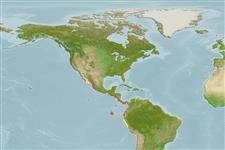Teleostei (teleosts) >
Carangiformes (Jacks) >
Carangidae (Jacks and pompanos) > Caranginae
Etymology: Selene: Greek, selene = moon (Ref. 45335).
More on author: Gill.
Environment: milieu / climate zone / depth range / distribution range
Ecology
Marine; benthopelagic; depth range 1 - 50 m. Tropical; 27°N - 18°S, 112°W - 70°W
Eastern Pacific: southern tip of Baja California, Mexico to Ecuador.
Size / Weight / Age
Maturity: Lm ? range ? - ? cm
Max length : 38.0 cm FL male/unsexed; (Ref. 9283); common length : 25.0 cm FL male/unsexed; (Ref. 9283)
Body short, deep, and strongly compressed; lower branch of first gill arch with 29 to 34 gill rakers; dorsal fin with 8 spines followed by another spine and 20 to 23 soft rays (VIII+1,20-23); anterior lobes of second dorsal and anal fins very long in adults; anterior dorsal spines greatly prolonged in juveniles; body scaleless; lateral line scutes very weak and poorly differentiated; body golden or silvery with metallic blue highlights; juveniles yellowish, with indistinct, interrupted, dark, transverse bars (Ref. 55763).
Adults are found in shallow coastal waters in small schools near the bottom (Ref. 9283). They feed on small squids, shrimps, polychaetes and small fishes (Ref. 9283). Marketed fresh and salted (Ref. 9283). Depth range assumed (RF).
Life cycle and mating behavior
Maturities | Reproduction | Spawnings | Egg(s) | Fecundities | Larvae
Smith-Vaniz, W.F., 1995. Carangidae. Jureles, pámpanos, cojinúas, zapateros, cocineros, casabes, macarelas, chicharros, jorobados, medregales, pez pilota. p. 940-986. In W. Fischer, F. Krupp, W. Schneider, C. Sommer, K.E. Carpenter and V. Niem (eds.) Guia FAO para Identification de Especies para lo Fines de la Pesca. Pacifico Centro-Oriental. 3 Vols. FAO, Rome. (Ref. 9283)
IUCN Red List Status (Ref. 130435)
Threat to humans
Harmless
Human uses
Fisheries: minor commercial; gamefish: yes
Tools
Special reports
Download XML
Internet sources
Estimates based on models
Preferred temperature (Ref.
123201): 21 - 28.4, mean 26 °C (based on 50 cells).
Phylogenetic diversity index (Ref.
82804): PD
50 = 0.5039 [Uniqueness, from 0.5 = low to 2.0 = high].
Bayesian length-weight: a=0.01862 (0.01098 - 0.03157), b=2.80 (2.66 - 2.94), in cm total length, based on LWR estimates for this species & (Sub)family-body (Ref.
93245).
Trophic level (Ref.
69278): 3.8 ±0.4 se; based on diet studies.
Resilience (Ref.
120179): High, minimum population doubling time less than 15 months (Preliminary K or Fecundity.).
Fishing Vulnerability (Ref.
59153): Low to moderate vulnerability (32 of 100).
Nutrients (Ref.
124155): Calcium = 124 [64, 264] mg/100g; Iron = 1.1 [0.6, 2.4] mg/100g; Protein = 17.1 [14.9, 19.4] %; Omega3 = 0.189 [0.093, 0.392] g/100g; Selenium = 56.5 [27.7, 135.1] μg/100g; VitaminA = 17.7 [4.5, 61.7] μg/100g; Zinc = 0.989 [0.640, 1.569] mg/100g (wet weight);
